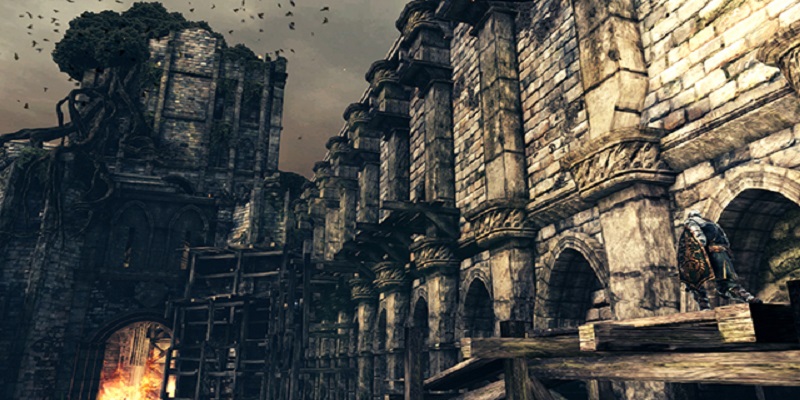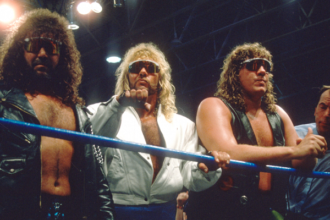Asymmetrical D&D: Ravenloft-ish

Forgive me Tribality, for I’ve been boring.
It’s been almost four months since I last ran a tabletop game, and two-ish since I have played in one. While I’m still gutted over not being able to keep playing my previous games, I’m realistic about the fact a three hour time difference is not really conducive to weekday play, but it doesn’t make me less sad I can’t keep playing with the groups I have been playing with over the last several years. Anyway, I’m trying not to look at it as something I’m losing, but an opportunity to try new things with different people. To that end, I’m going to be starting an asymmetrical D&D game, probably set in a Ravenloft-ish setting.
A Bit of Background
It’s weird. Even though I missed huge portions of 2018 in terms of playing games, I always knew I could run or play in games as soon as things calmed down. Now that I don’t have the possibility of playing in those games, it’s hit me pretty hard from a creative and enthusiasm standpoint. I know I will eventually end up playing in games where I am now, but those previous relationships are still important to me. As it stands, there is no way we can make a three-hour time difference work during the week, and weekends are right out of the question for similar reasons. Instead of accepting this reality, I’ve been thinking of options to pursue.
Right now, I know for certain I will be running a two-person D&D game set in the aforementioned Ravenloft-ish setting. By “Ravenloft-ish,” I mean a Dread Domain adhering to the rest of the built-in setting lore and mechanics, but not one of the existing Dread Domains. I’ve not run a game for such a small group before, and I want to make sure they get a great experience. It’s not that I’m not confident in my game-running – I think I’m fine, but can improve – but that I want to make sure the game has the fully-mutable story experience that comes from larger collaborative storytelling. This game is only going to have three viewpoints, unless I solicit others.
Things to Solve For
Part of my concern for this is the ease of one person being able to dominate the story and decision-making in a two-person game. It is, of course, part of the DM’s job to provide a collaborative environment for the players to engage with the game. However, there is a fine line between working diligently to encourage the not-as-vocal person in a low player game and seeming as if you aren’t supporting the vocal player. While it probably won’t be a problem, it’s still something I want to keep active in my mind. It’s really important to me that both players are equal partners with me in this experience.
This concern and my desire for including my various groups in future games has been bouncing around in my head for the last month or so. I thought about a full play-by-post game, but I don’t think I’d enjoy doing it, and it’s not the experience I want for the two players who are local. My concern would be responding in a timely fashion, and in a way that promotes narrative flow. I don’t have a lot experience with it, and I’m sure I’d make some easily preventable mistakes. Normally I wouldn’t mind making mistakes – that how you learn what works for you – but I want to make the experience great for both of these local players by providing an in-person experience. Obviously, I would provide that to the remote players, if I could.

Setting Goals
Okay, now that the background is out of the way, let’s talk establishing goals so we can measure the success of the campaign. In the below, whenever I say “story” I am referring to both the game world and all narrative components.
- Players and DM have fun
- Local and remote players will have different scales of story
- Local and remote players will have their own session zeros
- Remote players will engage with the story at individual (communicating with other remote players), company (leading a guild/adventuring hall), and domain (dread lord hype) levels
- Local players will engage with story at an individual (typical adventuring party) level
- Remote player company play will create beneficial and adversarial groups the local players will engage with
- Remote player doman play will shape the dread domains the players will engage with
- Local players will not have access to remote player’s discussion and vice versa
- Remote players will have a “window” to act
- Remote players will provide “general objectives,” allowing me to take action on their behalf if they do not specific specific actions during the “window”
- Communication between local and remote players will take the form of one-way communication (letters, message, etc.)
- The more I can get remote players to record audio or video, the better
- Real-time video and voice is not off the table, but should be use only for the rarest of climactic and dramatic events (eg. fighting Dracula in his castle or whatever)
- Local and remote players will have the opportunity to “buy back in” to the story, should they reach a fail-state (death, loss of an organization, domain dissolves, etc.)
Yikes! That’s a lot of setting goals. I could condense them down to fewer points, of course, but being explicit as possible is something I like to do in order to try and avoid confusion and ensure player alignment. These are all goals to strive to achieve, but I know that some of them are going to be more difficult than others. The most important goal is, of course, number one. As long as people have fun, it’s okay if the other goals change or we remove them.
I have my goals in place, and hopefully players are all on-board with them. Let’s say they are, for the purpose of continuing the discussion. I have yet to engage with the remote players and invite them to this whole thing, but I’m pretty confident they will have enough interest to give this a shot.
Implementation
This is all a nice outline, but it’s always about the execution. Turning the above points into something compelling for all parties is going to be a challenge, certainly. The design is still very much a work-in-progress, but I thought, perhaps mistakenly, that being wholly transparent in the process might interest others, as well. Some of this won’t have the full crunch that’s necessary, but I expect to work some of that out in more or less real-time as I see how the current implementation and story is going. A few of the systems are going to be a high-level design for now. We’ll see if that’s the right approach, but I expect the failures and successes of the earlier systems to inform the design of the later systems.
Local Player Session Zero
Local players will begin by rolling up several characters. I am thinking three characters to start, but I might do more if players like the overall process. The players will only give their characters first names, and they will write down a fourth name, as well. From that point, they will have a choice to create either a family estate, a small town, or a traveling caravan.They will create a relationship map, with a much tighter focus and two maps as output. The map will focus on:
- Three sub-locations (library, blacksmith, alchemy wagon, etc.)
- Two items with evocative names (The Rose of Evening, The Eye of Toln, etc.)
- Two major events (The Twilight Festival, The Great Feast, etc.)
- Two NPCs prominent in the location
- One “calamity” the location told stories about (a plague, famine, dust cloud, etc.)
The fourth name – the name players did not assign to a character – is the person who in charge of the location. This fourth person will be the center of the map, and the relationships will be off of them. Rather, they are the person who WAS in charge of the location, before it fell into ruin. player session zero, as it relates to the Dread Domain itself.
All three characters are descendants of the fourth name, and the players will select one of them to initially play. The players will pick a family name, a family motto, and a single word to describe the family. These feed into the background for character creation. The family motto will end up being the character’s ideal, and the single word will be the flaw. The hope is that these will be flexible enough to have different interpretations, while carrying a thematic throughline.
Remote Player Session Zero
Remote players will not be rolling up characters, per se. They will, however, be creating the NPCs for the campaign, or at least several of the important ones. The remote players will have a few items pre-populated for them at the start of their session. The “calamities” from the local player session zero will be nodes, and the overarching Dread Lord will already be present as the central node. The number of nodes and connections will scale depending on the number of remote players. I thinking three or four, but I’d honestly be fine with just one or two. Anyway, remote players will create a map with:
- NPCs that oppose the Dread Lord
- NPCs that align with the Dread Lord
- Organizations that oppose the Dread Lord
- Organizations that oppose the Dread Lord
- Locations within the Dread Domain
- Events from the life of the Dread Lord prior to the Dread Domain
- Events from the life of the Dread Lord during the Dread Domain
- Goals for the Dread Lord
- Dread Domains that connect to the active Dread Domain
The remote players will assign three defining words and a class to each NPC, as well. These words can be anything, but should be good enough to get a solid sense of each NPC. Their overall place in the world will come from the connections on the map. I know it seems like a lot of items, but it’s essentially simultaneous character and world creation for the remote players.

Remote Play
I am sure this most intriguing part of the post for anyone who’s made it this far. This is still all a work in progress, mind you. There are a lot of drivers for my decision-making around these guidelines. The first is the overall level of involvement. Keeping the necessary level of interaction to ensure this works is a challenge. The key is going to be producing artifacts from the local player game for the remote players to engage with. These will take the form of after-action reports, general rumor information, and, hopefully, letters from the players. After receiving the information, the remote play loop should look something like:
- Issue directives for chosen NPC/Organization – specific and general
- Local players interact with directives in live game
- Local players create artifacts for remote players
- Remote players receive post-game artifacts
- In-play communication between remote players via letters or similar means
- Apply advancement to NPC/Organization
- Create artifacts for local players
- Remote players issue new directives – specific and general
The time frame for this should be roughly a week, but that might vary depending on the local player game sessions. However, I believe it should be pretty easy to run at least twice a month, given the circumstances. The remote players will have the opportunity to advance the NPC or organization they are operating, creating more formidable allies or opposition within the world.
Buy Back
In a two-person game, having one character survive and the one not can be tricky. Given the circumstances, I don’t think easy resurrection is going to be on the table. The general plan for local players is to have them use the additional characters they create, should they die. If the organizations or NPCs the remote players control die, the remote players can elevate new NPCs to take over the gaps left behind in the world’s power structure. I should also note that players – local or remote – can opt to retire characters at any time if they just aren’t feeling them.
If one dies, some time will pass in game, and the remote players will be able to advance their plans without near-term opposition. If both die, the game advances a full generation. In the event of a generational shift, a few things occur. The remote players will have the opportunity to redefine their relationship maps, and further modify the game world. The local players will add the fallen character to their relationship map, and the event that led to their death.
The only upper-limit for this is the amount of fun the players are having, honestly. I don’t mind advancing the timeline for thousands of years, honestly.

To Be Determined
I’m still not quite sold on if the new characters start at level one. If they do, I want them to be able to define legacy abilities for these new characters, affording them extra oomph. They would probably earn these small bonuses through in-play action, and will take the form of keywords. For example, it might come up in a good scene that the dice favor the player in a drinking contest. Something like Iron Liver might end up as a bonus the character select, affording them advantage on Constitution throws when drinking. That’s a silly example, but you get the idea.
On the remote player side, as the players continue to advance, they will be able to take larger and larger reaching actions in the world. It is not entirely out of the realm of possibility that one of the NPCs they are representing ends up trying to push for a Dread Domain in their own right. That will probably entail a full new relationship map, with a link to the old one. It’s the ol’ vampire/death knight/werebadger problem. We all know it well, I am sure. One thing I know for sure is remote players will be able to troop build and assign templates to existing things – “skeletal” or “lycanthropic,” for example.
Okay, This is Long
Hopefully you find this interesting. I know it runs pretty long, but I think the information is good for discussion, if nothing else. I think this will prove different and intriguing for everyone involved. The local players have a keen interest in it, if nothing. Anyway, let me know what you think. I’m still open to suggestion, and look forward to a lively discussion – both here and with potential players.



